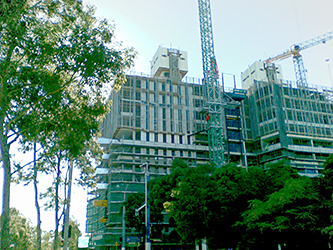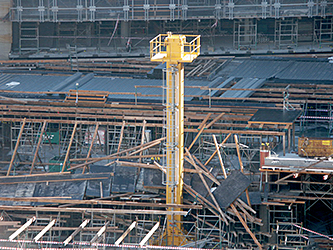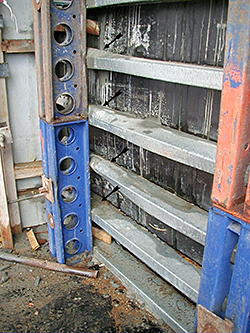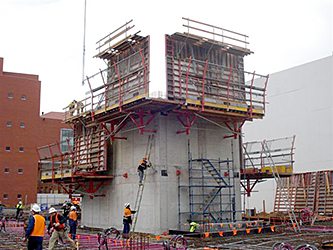FORMWORK AND SAFETY SCREEN SYSTEMS
Over the years we have been involved in the development of specialised static formwork and moving safety screen systems for the high rise market. This was done in a close working relationship with our clients and taking into account their specific needs and site restrictions.
 We utilised our extensive knowledge base to provide our clients with design and development of specialised static formwork systems, we have developed an expertise in various types of the self‑climbing formwork systems, which are capable of carry their own boom pumps, distribution arms, suspended scaffold and trailing screens.
We utilised our extensive knowledge base to provide our clients with design and development of specialised static formwork systems, we have developed an expertise in various types of the self‑climbing formwork systems, which are capable of carry their own boom pumps, distribution arms, suspended scaffold and trailing screens.
We have an extensive knowledge base of the multi‑level safety screen systems based on our involvement in the design and development of the site‑specific safety screen systems.
Our expertise in this specialised field had resulted in the design and development consultancy by contractors for projects Australia wide and throughout South East Asia.
Pursuant to the current building industry requirements, we offer our services for the purpose of pre‑placement structural inspections of soffit formwork assemblies. Over the years we have provided this service for many formwork contractors on a large portion of major building sites in Sydney.
 Over the time, researchers who have measured loads in formwork shores have consistently found that they differ from those predicted.
Over the time, researchers who have measured loads in formwork shores have consistently found that they differ from those predicted.
There is evidence that current design methods sometimes tend towards underestimating applied scaffold and formwork loadings. This generally happens through relative inexperience of the formwork design engineers and/or their failure to consider specific causes that may lead to situations where actual loads on formwork support systems are much greater than those predicted in accordance with AS3610.
In a majority of cases, especially for concrete placements of 200mm and over in thickness, reaction loads in supporting vertical supports/shores is likely to be non-uniform and sometimes exceed predictions.
The tributary area used in the general formwork design is the plan area of a slab influencing the load in a shore. The vertical support/shore design load, as calculated, is a function of its tributary area in addition to the load. Any evaluation should consider the adequacy of current practice over a range of tributary areas and concrete thicknesses.
 An experienced formwork engineer should consider asking some important questions:
An experienced formwork engineer should consider asking some important questions:
What causes the variability and non-uniform load distribution in vertical support systems?
Should a non-uniform load distribution in formwork be considered in other formwork elements other than vertical support system?
Should formwork design engineer consider non-uniform load distribution in vertical formwork?
Our extensive experience and knowledge suggests that the most likely cause of variability and non-uniform load distribution in vertical formwork support systems is a combination of:
concrete delivery methods;
placing patterns;
initial pre-loading;
lack of substructure or ground bearing;
differential settlement;
differential formwork structural member stiffness; and
formwork continuity.

| © 2015 T.O.P. Consulting Group (NSW) Pty. Ltd - All rights reserved. |
